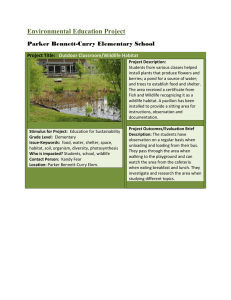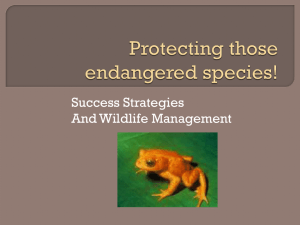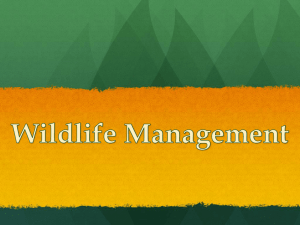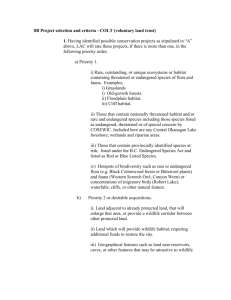Lesson 2 Wildlife and Conservation Management
advertisement
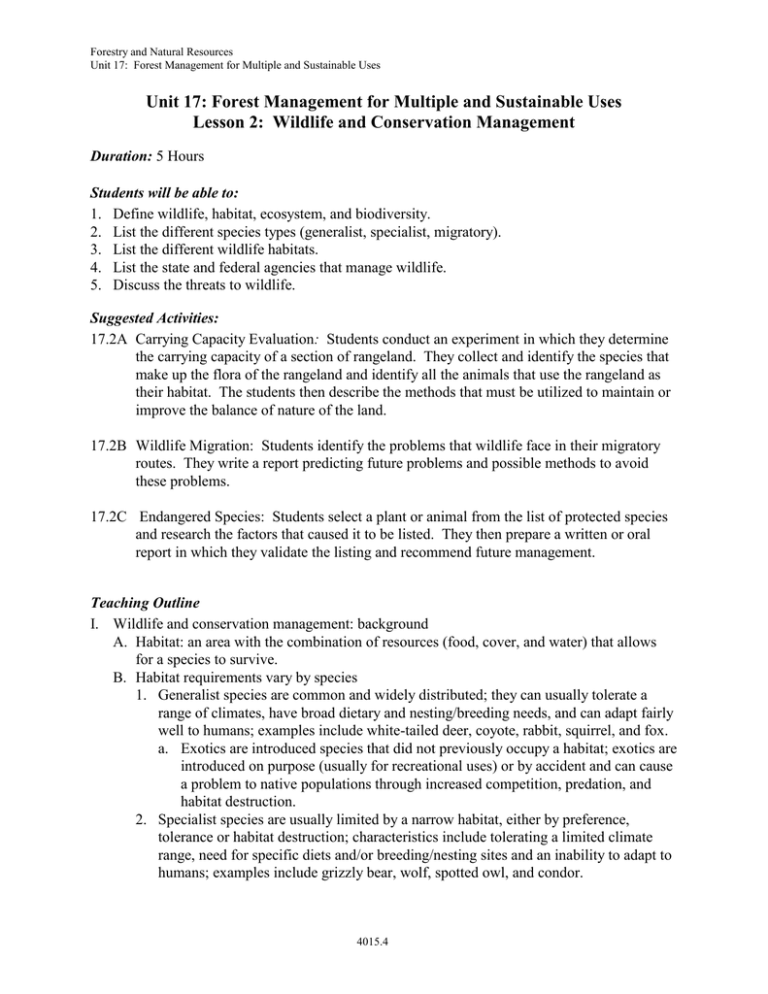
Forestry and Natural Resources Unit 17: Forest Management for Multiple and Sustainable Uses Unit 17: Forest Management for Multiple and Sustainable Uses Lesson 2: Wildlife and Conservation Management Duration: 5 Hours Students will be able to: 1. Define wildlife, habitat, ecosystem, and biodiversity. 2. List the different species types (generalist, specialist, migratory). 3. List the different wildlife habitats. 4. List the state and federal agencies that manage wildlife. 5. Discuss the threats to wildlife. Suggested Activities: 17.2A Carrying Capacity Evaluation: Students conduct an experiment in which they determine the carrying capacity of a section of rangeland. They collect and identify the species that make up the flora of the rangeland and identify all the animals that use the rangeland as their habitat. The students then describe the methods that must be utilized to maintain or improve the balance of nature of the land. 17.2B Wildlife Migration: Students identify the problems that wildlife face in their migratory routes. They write a report predicting future problems and possible methods to avoid these problems. 17.2C Endangered Species: Students select a plant or animal from the list of protected species and research the factors that caused it to be listed. They then prepare a written or oral report in which they validate the listing and recommend future management. Teaching Outline I. Wildlife and conservation management: background A. Habitat: an area with the combination of resources (food, cover, and water) that allows for a species to survive. B. Habitat requirements vary by species 1. Generalist species are common and widely distributed; they can usually tolerate a range of climates, have broad dietary and nesting/breeding needs, and can adapt fairly well to humans; examples include white-tailed deer, coyote, rabbit, squirrel, and fox. a. Exotics are introduced species that did not previously occupy a habitat; exotics are introduced on purpose (usually for recreational uses) or by accident and can cause a problem to native populations through increased competition, predation, and habitat destruction. 2. Specialist species are usually limited by a narrow habitat, either by preference, tolerance or habitat destruction; characteristics include tolerating a limited climate range, need for specific diets and/or breeding/nesting sites and an inability to adapt to humans; examples include grizzly bear, wolf, spotted owl, and condor. 4015.4 Forestry and Natural Resources Unit 17: Forest Management for Multiple and Sustainable Uses 3. Migratory species are animals that periodically or regularly move from one area to another for purposes of breeding, food forage, and/or to avoid extreme climatic conditions; migratory patterns can range from thousands of miles to less than 30, depending on species; problems can exist when animal cross political boundaries (states, provinces, countries) that have differing management plans and environmental laws; examples include caribou, bison, zebras, elephants, whales, bats, salmon, tuna, eels, and a number of birds, including swallows, ducks, geese and hawks. C. Ecosystem management recognizes that an “entire systems” approach needs to be taken and that we that we need to look beyond specific species and view the needs of the entire ecosystem. 1. All elements, including species composition, predation, physical conditions (soil, air, water) are inter-related, with management decisions affecting all parts of the system (from the largest mammal to the smallest insect). 2. Ecosystems range in size from very small (woodlots or ponds) to very large (rain forests or even an ocean). D. Biodiversity: the variety and variability of living organisms and their environments. E. Habitat corridors: habitat tracts in which wildlife can travel safely between sites (usually from one fragmented habitat to another), thus minimizing isolation. F. Major Wildlife Habitat Types 1. Forests 2. Rangelands 3. Riparian 4. Wetlands II. Management of wildlife A. Management by State and Federal Agencies 1. 1937 Federal Aid to Wildlife Act (Pittman-Roberston Act) levies an excise tax (11% in 1992) on the sale of sporting arms, ammunition and archery equipment; the money is redistributed to the states to use in a variety of wildlife programs. 2. 1966 Endangered Species Preservation Act (expanded in 1969 and renamed the Endangered Species Conservation Act; again modified in 1973 and renamed the Endangered Species Act (ESA): the ESA provides protection against extinction for all plant and animal species and subspecies; the act makes a distinction between endangered (likely to go extinct in all or some of its habitat range) and threatened species (likely to become endangered). a. To “list” a species, a group or individual must petition the Secretary of the Interior; submissions are judged by the United States Fish and Wildlife Service and the National Marine Fisheries Service. b. The process is lengthy, calling for a substantial public comment period, several public hearings and environmental impact statements. 4015.5 Forestry and Natural Resources Unit 17: Forest Management for Multiple and Sustainable Uses c. Listed species are protected from hunting and/or collecting, as well as protection for their critical habitat (even if it is on private land). i. Critical habitat is defined as the land a species occupies at the time of listing and the area deemed essential for conservation 3. 1976 National Forest Management Act (NFMA) requires tha.t a Forest Management Plan (see Unit 24, Timber Production) be drawn up for all production timber stands; plans must provide protection of both plant and animal diversity and insure that wildlife is considered in all management decisions. 4. 1976 Federal Land Policy Management Act (FLPMA) requires that the Bureau of Land Management take all resources into account in the planning process; also mandates that half the funds generated by grazing livestock on public lands is spent to improve natural rangeland, including fish and wildlife habitat. B. Management of Private Lands 1. The majority of land is the U.S. is privately owned. 2. Most states offer technical and financial assistance (Cooperative Extension field agents, loan programs, subsidies and tax incentives) to land owners to encourage habitat improvement. C. Management in Urban Areas 1. The U.S. is becoming increasingly more urban, resulting in more frequent encounters between humans and wildlife. 2. As urbanization continues, over-all species diversity drops. a. generalist species tend to increase, however, since they are better able to adapt to humans. 3. Highly adaptable urban species, such as crows, rats, and squirrels often reach such high densities that they’re considered pests. a. Control of these populations can be difficult, since hunting and trapping is generally prohibited (or greatly restricted) in urban areas. III. Threats to Wildlife A. Habitat Fragmentation and Loss 1. Fragmentation is the sever subdivision of once continuous habitat areas. 2. Cause of habitat fragmentation include land development (caused by urbanization), the conversion of wildlands to agricultural lands and the improper management of timber stand. 3. Fragmentation can result in an out-right loss of habitat, as well as blocking traditional migration routes. 4. Fragmentation usually results in contiguous habitat zones surrounded by areas of unsuitable habitat that isolates populations, limits genetic interchange (see Unit 19, Plant Biology), and can ultimately lead to extinction. 5. In some cases, well constructed habitat corridors can link fragmented lands. B. Conflict over habitat management 4015.6 Forestry and Natural Resources Unit 17: Forest Management for Multiple and Sustainable Uses 1. The rights of private land owners often conflicts with the concept of ecosystem management and conservation. a. The exception to this rule is in the case of an endangered species, since the land owner is obligated by law to conserve the species, as well as it. C. Human disturbance of wildlife 1. Many “wilderness-dependent” species are unable to handle disturbances by humans, with interaction often being fatal. 2. Some wilderness-dependent species become out-going and/or aggressive when they come into contact with humans. 3. Many species will simply move when they come into contact with humans; this, however is not always possible (see above) an the results can be tragic. 4. Recreational disturbances a. Hikers, campers, fishers, rock climbers, boaters, snow mobiles, off-road vehicles, etc. all impact the environments they use. b. Recreational users must be very careful not to disturb the areas they visit. c. Some activities (i.e., hunting, fishing, off-road vehicles) are prohibited in sensitive areas. 5. Poaching is the illegal killing of wildlife a. The definition includes killing protected species, killing out of season, hunting in protected areas, killing animals that are protected by sex, age or size, killing animals by illegal methods, or illegally collecting specimens (plants, invertebrates). b. State and federal agencies are increasing their attack on poachers, setting up decoys, monitoring critical areas, and implementing witness call-in hot-lines. c. Some poachers target specific body parts (for sale on the black market); examples include the gallbladder and paws of bears, and the antler of deer and elk. 4015.7

